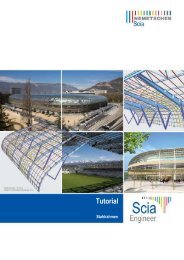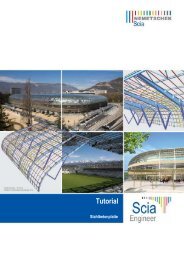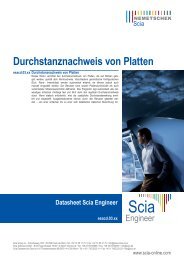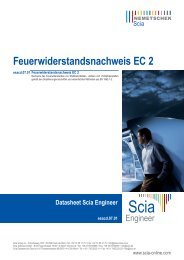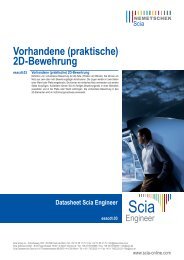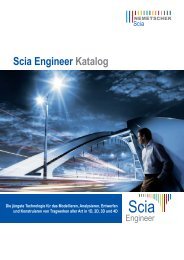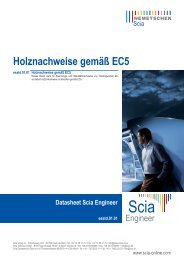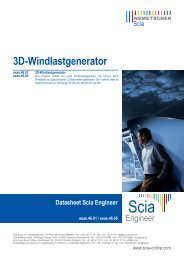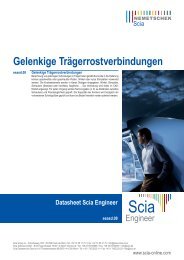Cold-formed steel design - Eurocodes
Cold-formed steel design - Eurocodes
Cold-formed steel design - Eurocodes
You also want an ePaper? Increase the reach of your titles
YUMPU automatically turns print PDFs into web optimized ePapers that Google loves.
<strong>Cold</strong>-<strong>formed</strong> <strong>steel</strong> <strong>design</strong><br />
esasd.15.01 <strong>Cold</strong>-<strong>formed</strong> <strong>steel</strong> <strong>design</strong> according to EC-EN1993-1-3<br />
The <strong>steel</strong> <strong>design</strong> module <strong>Cold</strong>-<strong>formed</strong> <strong>steel</strong> <strong>design</strong> according to EC-EN1993-1-3 is<br />
an extension to the EC-EN module esasd.01.01 for <strong>steel</strong> code check and focuses<br />
on the <strong>design</strong> of cold <strong>formed</strong> profi les according to the European Standard EC-EN<br />
1993. Both section checks and stability checks can be per<strong>formed</strong> in the same way<br />
as for standard profi les.<br />
Datasheet Scia Engineer<br />
esasd.15.01<br />
Scia Group nv • Industrieweg 1007 • B-3540 Herk-de-Stad • Tel: +32 13 55 17 75 • Fax: +32 13 55 41 75 • info@scia-online.com www.scia-online.com
<strong>Cold</strong>-<strong>formed</strong> <strong>steel</strong> members are made from structural<br />
quality sheet <strong>steel</strong> and are <strong>formed</strong> to the<br />
final shape either through press-braking blanks<br />
sheared from sheets or coils, or more commonly,<br />
by roll forming the <strong>steel</strong> through a series of dies.<br />
No heat is required to form the shapes (unlike<br />
for hot-rolled <strong>steel</strong>), which gives them the name<br />
“cold-<strong>formed</strong> <strong>steel</strong>”. <strong>Cold</strong>-<strong>formed</strong> <strong>steel</strong> members<br />
and other products are thinner, lighter, easier to<br />
produce, and typically cheaper than their hotrolled<br />
counterparts. A variety of <strong>steel</strong> thickness<br />
is available to suit a wide range of structural and<br />
non-structural applications.<br />
The <strong>steel</strong> <strong>design</strong> module according to EC-EN1993-<br />
1-3:2006 for the <strong>design</strong> of cold-<strong>formed</strong> <strong>steel</strong><br />
members is integrated within the existing <strong>design</strong><br />
of <strong>steel</strong> members according to Eurocode and is<br />
an extension to the standard <strong>steel</strong> code check<br />
(esasd.01.01).<br />
This module covers the following:<br />
• Determination of the initial shape;<br />
• Calculation of the effective section properties<br />
including local and distortional buckling;<br />
• ULS <strong>design</strong> checks;<br />
• Special considerations for purlins restrained by<br />
sheeting.<br />
Supported cross-section types<br />
The following cross-section types are supported<br />
for the generation of initial shape and effective<br />
cross-section:<br />
• Standard profile library cross-sections;<br />
• <strong>Cold</strong> <strong>formed</strong> pair cross-sections;<br />
• General thin walled sections;<br />
• General sections with thin walled representation;<br />
• Thin walled geometric sections;<br />
• All other sections which support the centreline<br />
and do not have rounding.<br />
Using the general cross-sections editor, it is possible<br />
to draw user-defined cross-sections with the<br />
integrated drawing tools or to import cross-sections<br />
from dxf- or dwg-files.<br />
The average yield strength is supported as implemented<br />
in EN 1993-1-3. This option is editable in<br />
the case the fabrication type is set to cold <strong>formed</strong>.<br />
The choice between ‘Roll forming’ and ‘Other<br />
method’ will adapt the k factor as described in EN.<br />
In the <strong>design</strong>, the <strong>steel</strong> core thickness (excluding<br />
coating) is used instead of the total thickness of<br />
the cross-section. The metallic coating thickness<br />
is input by the user and the ‘core thickness’ is then<br />
calculated and displayed.<br />
Determination of the Initial Shape<br />
When a cold <strong>formed</strong> section is selected from the<br />
standard library or when it has been imported via<br />
the general cross-section utility, the initial shape of<br />
the cross-section is automatically calculated and<br />
divided to several parts and visualized. Supported<br />
element types (I (internal element), F (fixed element<br />
– no reduction is needed), SO (symmetrical<br />
outstand element), UO (unsymmetrical outstand<br />
element) and reinforcement types (RUO)) are<br />
automatically associated during this process.<br />
<strong>Cold</strong>-<strong>formed</strong> <strong>steel</strong> <strong>design</strong> according to<br />
EC-EN1993-1-3<br />
Highlights NEW<br />
► Fully integrated cold <strong>formed</strong> checks in the<br />
standard Scia Engineer EN 1993 <strong>steel</strong><br />
<strong>design</strong> environment, including mixed material<br />
structures<br />
► Detailed analysis of the effective shape,<br />
including distortional buckling for edge stiffeners,<br />
double edge folds and internal stiffeners<br />
► Advanced checks available as web crippling<br />
and shear in case of sections with stiffened<br />
webs<br />
► Special purlin <strong>design</strong> checks including<br />
free flange geometry, advanced loading<br />
determination...<br />
► Available for arbitrary cold <strong>formed</strong> sections,<br />
including the average yield strength and <strong>steel</strong><br />
core thickness<br />
► Implementation of the latest EN 1993-1-<br />
3:2006 (including the 2009 correction sheet)<br />
Required module: esas.00 esasd.15.01
<strong>Cold</strong>-<strong>formed</strong> <strong>steel</strong> <strong>design</strong> according to<br />
EC-EN1993-1-3<br />
These elements are taken between the roundings<br />
and in case there is no rounding, the part is taken<br />
between the crossing points of the centre lines.<br />
The generated initial shape can be viewed and<br />
modified by the user.<br />
The initial shapes can be checked manually,<br />
before being applied to the model, for compression<br />
and bending according to both local axes.<br />
Effective shape<br />
For the initial shapes within Scia Engineer, the<br />
elements are determined between the roundings.<br />
For the calculation of the effective width, however,<br />
the notional width is used. This is specified in EN<br />
1993-1-3 art 5.1 and figure 5.1 pp 19. The effective<br />
width based on the notional width is recalculated<br />
again to determine the effective width of the<br />
element in Scia Engineer.<br />
For the definition of the compression and bending<br />
stresses the code does not require use of iterations,<br />
stiffener iteration and overall cross-section<br />
iteration, but these can be selected optionally in<br />
the <strong>steel</strong> setup of Scia Engineer.<br />
The effective width of Internal Compression<br />
Elements and Outstand Compression Elements<br />
is calculated according to EN 1993-1-5 art.4.4.<br />
The procedure for determining the effective width/<br />
thickness of plane elements with edge stiffeners is<br />
given in EN 1993-1-3 art.5.5.3.2 and art.5.5.3.1.<br />
The procedure for determining the effective width/<br />
thickness of elements with intermediate stiffeners<br />
is given in EN 1993-1-3 art.5.5.3.3 and art.5.5.3.1.<br />
The obtained effective sections can be displayed<br />
graphically.<br />
esasd.15.01<br />
Section and stability checks<br />
The general Scia Engineer <strong>steel</strong> code check can<br />
be run, including AutoDesign and Single Check.<br />
Additional information can be defined on the <strong>steel</strong><br />
member to specify the boundary conditions:<br />
• Member buckling data;<br />
• LTB restraints;<br />
• Stiffeners;<br />
• Diaphragms.<br />
Diaphragms are used in the same way as currently<br />
implemented in Scia Engineer. Bow imperfection<br />
for LTBII and the national annex parameters are<br />
supported as well.<br />
Section Checks<br />
In contrast to EN1993-1-1, there is no classification<br />
for cold <strong>formed</strong> sections according to<br />
EN1993-1-3.<br />
Since the checks depend on effective properties<br />
calculated in the cross-section manager, the cold<br />
<strong>formed</strong> EC-EN checks are not valid for haunches<br />
and arbitrary members or for members which<br />
do not have the initial shape. In such cases the<br />
default EN 1993-1-1 code check will be executed.<br />
The following section checks are executed: Axial<br />
Tension, Axial Compression, Bending Moment,<br />
Shear Force, Torsional Moment, Local Transverse<br />
Forces, Combined Tension and Bending,<br />
Combined Compression and Bending, Combined<br />
Shear, Axial Force and Bending Moment,<br />
Combined Bending and Local Transverse Force.<br />
Stability Checks<br />
The following stability checks are per<strong>formed</strong>:<br />
Flexural Buckling, Torsional and Torsional-<br />
Flexural Buckling, Lateral-Torsional Buckling (LTB<br />
is done completely according to EN 1993-1-1.<br />
For the calculation of the elastic critical force, the<br />
cubic equation algorithm is used), Bending and<br />
Axial Compression, Bending and Axial Tension,<br />
Combined Bending and Tension check.<br />
For the calculation of bending and axial compression,<br />
EN 1993-1-3 allows two possibilities, so the<br />
user can choose:<br />
• EN 1993-1-1 interaction according to article<br />
6.3.3 (the cold–<strong>formed</strong> sections will be seen as<br />
class 3 or 4.);<br />
• Alternative method according to EN 1993-1-3<br />
article 6.2.5(2).<br />
Purlin <strong>design</strong><br />
For the cross-sections that meet all requirements<br />
of Chapter 10, the reduced default checks are<br />
executed. This means that not all default checks<br />
will be executed and that the special purlin<br />
checks according to Chapter 10 will be per<strong>formed</strong><br />
(Diaphragm on the compression side, Diaphragm<br />
on the tension side, Definition of the free flange<br />
geometry, Determination of the equivalent lateral<br />
load, Determination of the lateral bending<br />
moment, Determination of the distance between<br />
anti-sag bars, Determination of the lateral spring<br />
stiffness, Buckling resistance of the free Flange).



